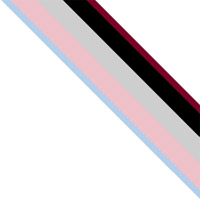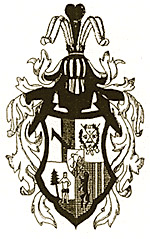Landsmannschaft Hercynia Mainz
The compatriot Hercynia Jenensis et Hallensis in the CC in Mainz is a colored and obligatory student union . She is a member of the Coburg Convent (CC).
General
Surname
Hercynia is derived from the term used by the Roman historian Tacitus (around 58-120) for the forest areas from the edge of the Alps to the Harz Mountains as hercynia silva (German "Herzynische forests", Latin hercynia silva , Greek Arkynia ). Several student associations have this name.
Colours
As Couleur has Landsmannschaft the color "light blue, pink, silver, black and wine red" is selected. These refer to the old traditions, were freely chosen and are not based on the Empire or any other political era. Hercynia was originally founded as a Humanitas and over time developed into the Hercynia Landsmannschaft.
Motto
The motto is: "Friendship and honor".
history
Hercynia Mainz is a merger of Hercynia Jena and Hercynia Halle, which is why the members bear the name Jenensis et Hallensis to this day.
History of Hercynia Jena
It was founded in Jena on June 18, 1872 as the “Humanitas” regulars' table.
A year later, in 1873, the union was renewed and took the form of a union that represented the humanistic idea.
The majority of the members came from simple, humble backgrounds. Therefore, the external form of Humanitas, deliberately deviating from the already existing connections, was rather simple and without an overly tight comment . It was up to each individual to give satisfaction.
The coat of arms shows the circle in the middle, three spruce trees for the Thuringian Forest as the place of birth, lyre and Kommersbuch for the student singing, date of foundation, wooden jug as a symbol for the Lichtenhain beer , the clasped hands for friendship and the crossed bats for the satisfaction . This coat of arms was slightly modified in 1883. The coat of arms is shown in the form of 1883.
In 1878 the name of the now internally and externally tighter Humanitas was changed to Hercynia and its general image was brought into line with the other connections, the Paukboden became mandatory and the colors changed to black-white-black.
In 1881 the satisfaction for Hercynen became compulsory, in 1882/1883 Hercynia and Salia acquired their own weapons.
In 1883 Hercynia became a color-bearing, exposed connection with the colors pink-white-black (read from below, as is typical for all Jenenser connections), the old colors black-white-black became the Fuxen colors , and the pink cap was introduced in Biedermeier format .
Since 1888 there was a friendship relationship with Hercynia Halle.
In 1890 Hercynias Alte Herren merged to form an old gentlemen 's association based in Gotha . They introduced and confirmed the motto "Friendship and Honor", the determination of the degree and the unconditional satisfaction, the AC (General Convent) and the BC (Boys' Convent).
By 1906 the Hercynia was strengthened and increased in number. In 1906 a separate corporation house was built at Johannisplatz 30 and completed in 1907, although it was demolished in 1969 for the construction of the Uniturm.
In the winter semester of 1927/1928 114 lengths were fought on Jenenser Hercynen colors, fifteen of them were saber parts.
In the summer semester of 1928 Hercynia reached the highest level of active participation with 21 Krassfüxen and 51 members; In 1929 the friendship with the Academic Landsmannschaft der Salzburger was established.
1933 brought the known changes. After the suspension of Aktivitas on March 31, 1936 and the dissolution of the umbrella organization of the German Landsmannschaft (DL), Hercynia had to transform itself into a comradeship . The life of communion was carried on in secret as far as possible.
History Hercynia Hall
On January 22nd, 1880, students from Halberstadt , who had previously met in Leipzig for a Halberstädter Evening, gave themselves a fixed form and called themselves "Halberstädter Verein", which from July 19, 1880 was called "Connection Halberstadtensia". This led the colors blue-white-red in the coat of arms and beer tails and was a founding member of the Gotha First Convent in 1881 , from which it left in 1882. Since the offspring from Halberstadt alone did not secure the existence, she changed her name to Hercynia in the summer semester of 1882. Hercynia changed the colors into light blue-silver-wine-red, the motto became “The heart of the friend, the ore for the enemy!” The cap was light blue and had the Biedermeier format.
The coat of arms now showed the circle with the colors in the middle and the following in the four fields: At the top left the wreath with two crossed bells, the day of the foundation and the founding members with a corresponding number of crosses. At the top right you can see the Halberstadt city arms. Below left the Leipzig city arms and below right the Wild Man as a symbol of the Harz Mountains . Determination censorship and unconditional satisfaction were also accepted.
In March 1884 Hercynia had to relocate to Halle because a dispute before the university judge imposed an adjournment and made it difficult to open again in Leipzig. On March 10, 1884 Hercynia was relocated to Halle. In the winter semester of 1886/1887, the light blue silk storm was introduced as a summer hat. Hercynia had to suspend from 1894 to 1902 due to a lack of assets.
In order to strengthen the viability and to enable the reconstitution, she took over the Free Student Association Armino-Marcomannia on December 10, 1902. Both had been scientific connections.
In 1910 Hercynia bought a house on Wettiner Strasse.
In 1922/23 the friendship with Hercynia Jenensis was broken.
The development from 1933 is similar to that of Hercynia Jena.
Reconstitution and merging to L! Hercynia Jenensis et Hallensis
Hercynia Jena and Hercynia Halle lost their ancestral home during the Second World War.
As luck would have it, some of the Jenens friars found their place of residence in Mainz-Bischofsheim, so that a Hercynent meeting took place there on November 26, 1949.
On September 17, 1950, the old gentlemen's association was reconstituted, and in 1951 the decision was made to reopen the activities of the Landsmannschaft in Mainz .
Hercynia was reconstituted in Mainz on April 30, 1952. The restaurant and butcher shop "Vonderheit" in Mainz-Bretzenheim acted as accommodation in the 90% destroyed city.
In the same semester, timpani and mensur wichs were purchased and it was determined that only active people who have fought can be received.
In the summer semester of 1953, contacts were made with the old men of the Hercynia Hallensis, a commemoration of the friendship relationship that existed before anything that separated the 1930s. In 1954 a working group was founded.
On August 1, 1955, the 75th Hercynia Halle foundation festival, the two Hercynia merged to form Hercynia Jenensis et Hallensis in Mainz, with the pink hat for everyone.
In 1960 it was decided to merge the colors into light blue-pink-silver-black-wine-red as a lady's ribbon and pink-light blue as fuxen colors (read from bottom to top).
The hat remained the pink Biedermeier hat with a pink-silver-black ribbon, the circle was the old Jenenser Hercyne circle, the coat of arms was redesigned. The heraldic shield is quartered and covered with a heart shield, which shows colors and compasses. The upper right field shows three green fir trees as symbols for the Thuringian and Harz forests. The three remaining fields point to the old and new home and university: top left moon / lorry and stars / salt crystals for Halle (from Halit = rock salt), bottom left Georg and the dragon for Jena and bottom right the silver double wheel on a red background for Mainz.
In the helmet ornament and the helmet cover, the colors pink-silver-black are shown from left to right. From 1953 to 1957, the “wine pump” in Gaustraße served as a dormitory and federal home. In the course of time, the house was changed several times until the current house at Kapellenstrasse 14 was acquired in May 1966, and in 1967 it was inaugurated at the 95th foundation festival.
The Jenenser house was blown up in 1969 to build the Zeiss tower. The Halle house is still standing, albeit in poor condition. In spite of this, the Jenenser and Halle traditions were and are maintained.
Known members
- Walter Bauer (1893–1968), as a chemist of acrylate chemistry, he is considered the inventor of Plexiglas. He was head of the research laboratory of the Röhm und Haas company in Darmstadt, is named as the (co-) inventor of over 90 patents and in 1962 received the Rudolf Diesel Gold Medal for his achievements.
- Walter Reppe (1892–1969), Nobel Prize-nominated chemist and representative of modern process engineering, who significantly developed acetylene chemistry.
See also
literature
- Michael Doeberl , Alfred Bienengräber (Ed.): The academic Germany. Volume 2: The German universities and their academic citizens. CA Weller, Berlin 1931. pp. 818, 873.
Individual evidence
- ↑ Meyers Konversationslexikon . 5th edition, Leipzig 1896, supplement to the article student associations .





